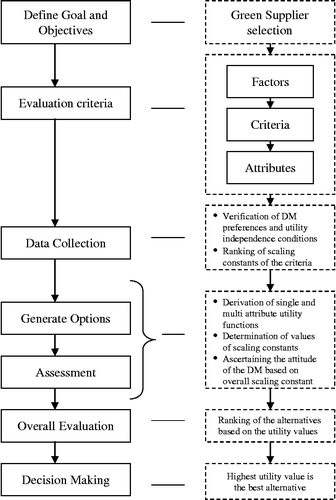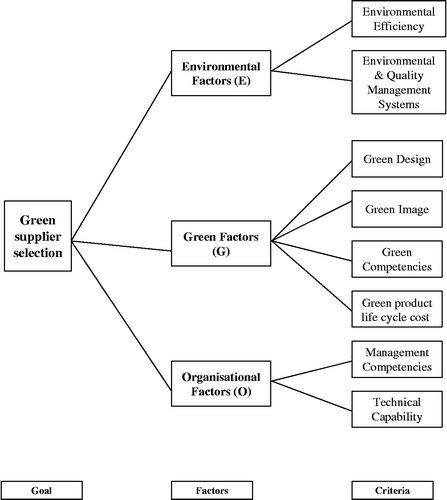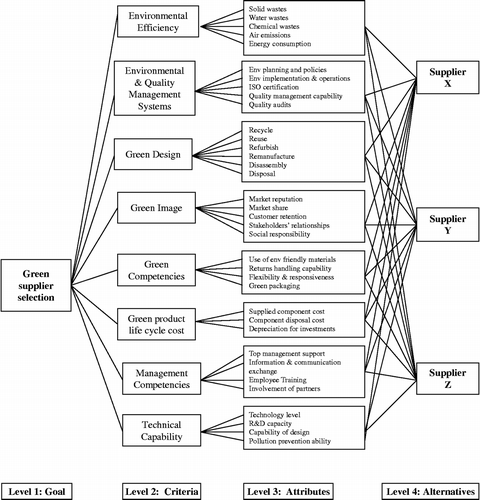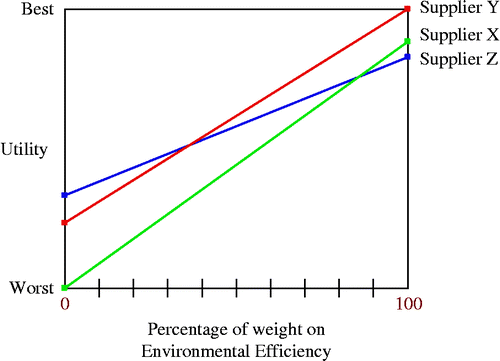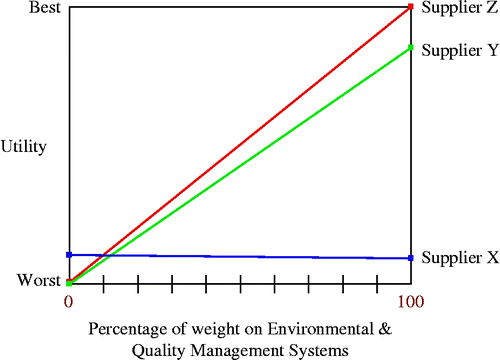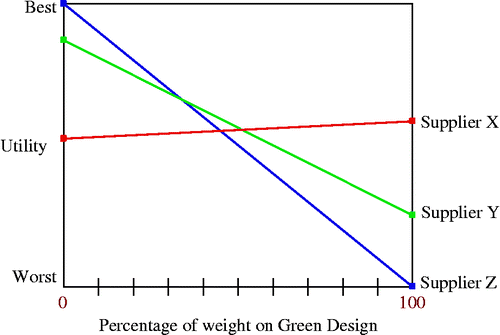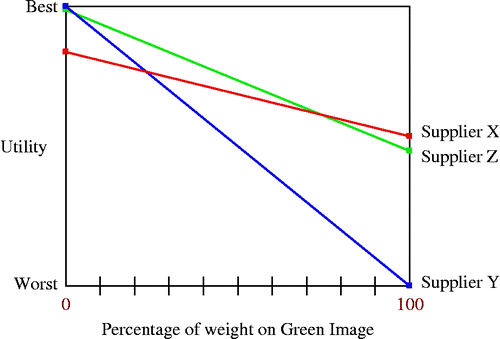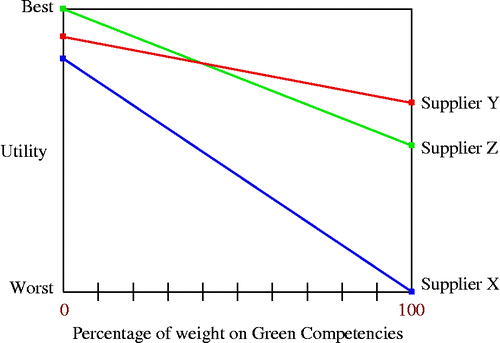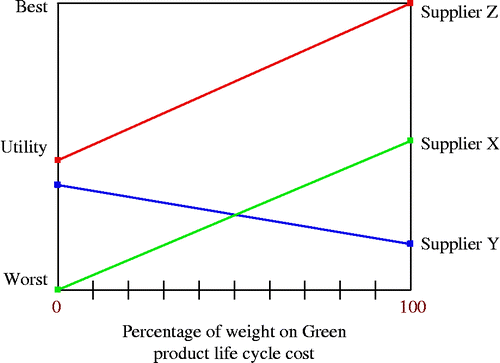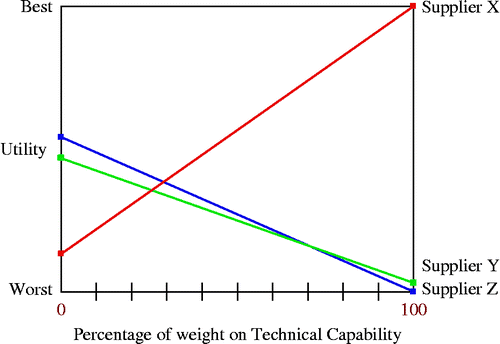Abstract
This paper presents a generic framework integrating environmental and social criteria leading to a comprehensive selection process of green suppliers. Traditionally, price, quality, lead time and flexibility are considered for the supplier selection. With the increase in awareness of environmental and social responsibility issues, many companies are tending towards adopting green concepts and sourcing green suppliers. This study proposes a framework consisting of environmental (E), green (G) and organisational (O) factors that are required for the green supplier selection process. These factors are further classified as criteria for which attributes are presented. A hierarchy is constructed to facilitate in evaluating the importance of the selected criteria and alternatives of green suppliers. To cater to the multi-criteria decision-making approach with both quantitative and qualitative attributes, we applied the multiple attribute utility theory, which is a decision support that helps managers formulating viable sourcing strategies. A hypothetical example is presented to illustrate the applicability of the approach.
1. Introduction
Competitive advantages associated with supply chain management (SCM) can be achieved by strategic collaboration with suppliers and service providers. The success of a supply chain is highly dependent on the selection of good suppliers. Multiple criteria need to be taken into account when selecting suppliers. The supplier selection problem has received considerable attention in academic research and literature. The selection of a good supplier to work with is crucial to a company's success. In today's competitive operating environment, it is impossible to successfully produce low-cost, high-quality products without suitable suppliers. Thus, one of the important purchasing decisions is the selection and maintenance of a competent group of suppliers (Weber et al. Citation1991). In recent years, an additional strategic dimension of suppliers has been taken into account and has been related to their contribution to sustainable development, and more specifically to the environment (Humphreys et al. Citation2003b).
The integration of environment, economic and social performances to achieve sustainable development is a major business challenge for the new century (Verghese and Lewis Citation2007). Environmental management is important for organisations as the emphasis on environment protection by stakeholders, governments, customers, employees, competitors and communities is increasing. As environmental awareness increases, buyers today are learning to purchase goods and services from suppliers who can provide them with low-cost, high-quality, short lead time and at the same time with environmental and social responsibility. In order to have a long-term success and existence in the global market, an organisation should not only stress on financial status in evaluating suppliers, but also consider various criteria, including pro-environmental and social concerns. Therefore, green procurement approach must be compliant with customers, laws and regulations, and a green supplier selection is necessary for an organisation in determining the suitability of a supplier as a partner in the green supply chain. Green SCM is generally understood to involve screening of suppliers based on their environmental performance and doing business only with those who meet certain environmental regulations or standards (Rao Citation2002). The collaboration among the members of a supply chain might foster the development of improved environmental practices (Vachon and Klassen Citation2006). Hence, the most basic understanding of ‘green’ is about minimising/eliminating potential negative environmental impacts and using all of the resources as efficiently as possible by continually seeking to eliminate all types of waste, protect the environment and increase operational efficiency to become more sustainable, while reducing total costs. Therefore, a green supplier is one whose management consciously emphasises the consideration of protecting and developing stakeholder's environmental, health and safety concerns into all business decisions as a form of responsibility and continuing the effort to deliver positive contributions to the society. Considering its importance, many companies have begun to give more attention to their suppliers' environmental performance. This paper presents a decision framework for selecting ‘green’ suppliers who effectively take environmental and social performances into account in their operations.
In the present world, selecting an appropriate supplier is often a non-trivial task, in which multiple criteria are needed to be carefully examined. However, many decision makers (DMs) select suppliers based on their experience, knowledge and intuition. These approaches are obviously subjective and their weakness has been addressed in previous studies (Kontio Citation1996). Weber et al. (Citation1991) indicated that supplier selection decisions were complicated by the fact that various criteria must be considered. Among the various methods utilised, multiple criteria decision making or multiple attributes decision making (MCDM/MADM) is one of the approaches dealing with the ranking and selection of one or more suppliers from a pool of providers. The MCDM provides an effective framework for suppliers comparison based on the evaluation of multiple conflicting criteria. De Boer et al. (Citation2001) gave a good review and classification of the MCDM approach for supporting supplier selection. Consequently, there are various MCDM/MADM approaches applied to supplier-related problems. The motivation behind our work is to present to the DM a tool that would help in assessing and selecting the suitable suppliers. According to De Boer et al. (Citation2001), a supplier selection problem typically consists of problem definition, formulation of criteria, qualification of suitable suppliers and final selection of the ultimate supplier(s). Generally, both quantitative and qualitative types of attributes are dealt with for the selection of suppliers. The attributes for supplier selection are well documented in the literature but there is a lack of relevant attributes in the area of green supplier selection. However, to the best of our knowledge, there is no integrated and comprehensive framework in the literature for green supplier selection that incorporates both the traditional and environmental factors. This has led to the development of the criteria and generic framework for the green supplier selection. In this research paper, the problem definition along with the formulation of criteria for the qualification of suitable green suppliers is presented. Due to its nature, the selection process of green suppliers requires an appropriate multi-criteria analysis. Accordingly, the proposed decision framework considers both qualitative and quantitative factors by making use of the multiple-attribute utility theory (MAUT) presented by Keeney and Raiffa (Citation1993).
The remainder of this paper is structured as follows: the literature review is presented in Section 2, multi-attribute utility theory is covered in Section 3, the development of green supplier selection criteria and framework, and application of MAUT for green supplier selection with results and discussions are given in Sections 4 and 5 and Section 6 is dedicated to the conclusions and recommendations for future research.
2. Literature review
In supply chains as firms are increasingly becoming outsourcing oriented, supplier selection has become a major strategic decision for manufacturers. Interestingly, manufacturers are selecting those suppliers that can deliver required raw materials and components at high-quality level with low cost to satisfy customer demand. Furthermore, with increasing consumerism and the concern about the environment, manufacturers are consciously developing a consumer and environment friendly image. Collaborating and partnering with the right suppliers has become a key factor to the success of manufacturers (Ellram et al. Citation2002). Hsu et al. (Citation2006) pointed out that suppliers play a vital role in creating a competitive advantage and their actions have a positive impact on the organisation's performance. In the literature, research on supplier selection can be traced back to the early 1960s. Weber et al. (Citation1991), Ghodsypour and O'Brien (Citation1998) and De Boer et al. (Citation2001) did extensive literature overviews on methods and tools for supporting supplier selection. Generally, in supplier selection decisions, two issues are of particular significance. One is what criteria should be used, and the other, what methods can be used to compare suppliers. In the following subsections, we present the literature review of supplier selection attributes with focus on environmental issues, and supplier selection methods.
2.1 Supplier selection attributes and environmental criteria
From the supplier selection literature, price, quality, lead time, service and delivery are the five primary criteria used in the supplier selection problem. Dickson (Citation1966) published the most important work in this context with the identification of 23 criteria that have been considered by purchasing groups in various supplier selection problems. Furthermore, Stamm and Golhar (Citation1993), Ellram (Citation1990) and Roa and Kiser (Citation1980) presented, respectively, 13, 18 and 60 criteria for the supplier selection process. Since the Dickson's (Citation1966) study, many researchers have identified sets of supplier selection criteria varied by industry and buying situations. Among them are Min (Citation1994), Humphreys et al. (Citation1998), Ghodsypour and O'Brien (Citation1998), Motwani et al. (Citation1999), Tam and Tummala (Citation2001), Bharadwaj (Citation2004), Liu and Hai (Citation2005). Recently, En et al. (Citation2008) have classified the criteria and the metrics for supplier selection, such as cost, quality, service, reliability, management, and organisation and technology. It is evident from the body of knowledge on supplier selection, the trend is to consider traditional attributes with almost no focus on environmental and social considerations.
The supplier selection process becomes more complicated when environmental and social issues are considered. This is because green supplier selection must consider the supplier's environmental and social responsibility and the traditional attributes such as costs, quality and service. The selection of suppliers based on strict environmental compliance is not sufficient, and a clear strategic approach is further required for green supplier selection. In the last decade, a number of researchers have identified environmental criteria. Lamming and Hampson (Citation1996) were first to propose a series of environmental indicators for supplier selection. In their study, they concluded that there is no standard form for criteria and also there is no coordinated response to deal with the environmental issues, and each of the companies in the study had used a different approach to their individual understanding. This study showed how companies are viewing environmental issues, but did not provide any standard form of environmental considerations. Sarkis et al. (Citation1996) considered the environmental criteria such as design for the environment, life-cycle analysis, total quality environmental management and ISO 14000 environmental management system requirements. However, these criteria are used to evaluate the existing internal operations for their environmental performance, rather than using the criteria to evaluate suppliers. Noci (Citation1997) designed a green supplier rating system for the assessment of a supplier's environmental performance with perspectives using four categories: green competencies, current environmental efficiency, supplier's green image and net life-cycle cost. However, the framework provides limited and brief overview of the selection process and did not consider issues related to design for environment and the implementation of the environmental management system. Walton et al. (Citation1998) presented a flow chart for determining appropriate methods and criteria for supplier evaluation in environmental management. Enarsson (Citation1998) presented the supplier selection problem from an environmental viewpoint by adopting a quality improvement prospective where four main qualitative factors have been identified: the supplier as a company, the supplier's processes, the product itself and transportation. This study lacks the quantitative aspects of environmental issues such as the amount of energy consumption and waste emissions. The environmental criteria and assumptions for supplier selection based on environmental performance are encouraging and they tend to be more of a theoretical argument rather than an organisational practice inserted in the dynamic of the supply chain (Ofori Citation2000). Zhu and Geng (Citation2001) examined companies with their environmental developments such as green purchasing in their business practices. The authors mentioned that the management of suppliers based on strict environmental compliance is not sufficient, and a more proactive and strategic approach is required. However, there are few theoretical–empirical studies that consider environmental criteria in the supplier selection process (Lin et al. Citation2001). Handfield et al. (Citation2002) reported that in practice, firms opt for criteria that require simplified analysis instead of more sophisticated and important environmental criteria. Humphreys et al. (Citation2003b) identified and classified environmental criteria as quantitative and qualitative. A decision-support system was presented to integrate the environmental criteria into the supplier selection process. In their paper, only costs are considered for quantitative factors, and there is no consideration of social issues. Chen (Citation2005) divided the supplier selection process into two phases. The first phase considers environmental performance as the minimum requirement, and the second phase takes into account general purchasing practices such as quality, delivery and performance records. The condition is that only the suppliers who have ISO 14000 certification can be included in the second-phase selection. This study merely considers the implementation of ISO 14000 as a criterion which definitely does not guarantee that the supplier has a good environmental performance record. Kongar (Citation2005) introduces environmental consciousness indicators such as recyclability of goods, decreased amount of hazardous substance and compatibility with health and safety regulations into the supplier evaluation process. But these are not sufficient for the selection of suppliers.
Considering the environmental criteria and based on buyer–supplier relationship, Huang and Keskar (Citation2007) organised the supplier performance metrics into seven categories and three tracks: product related (reliability, responsive and flexibility), supplier related (cost and financial, and assets and infrastructure) and society related (safety and environmental).
Although the above reported research works identify the need and tendency to include environmental criteria in the supplier selection process, they fail to systematise and categorise. They do not provide a comprehensive framework of attributes consisting of both traditional and environmental criteria for green supplier selection. More importantly, these criteria keep changing over time. Through an extensive and a state-of-the-art literature review, the supplier selection attributes were consolidated, classified and categorised into six main criteria, as shown in Table . They are (i) cost and financial, (ii) quality, (iii) service, (iv) technical, (v) organisation and (vi) environmental. These attributes are broadly referred for their assimilation into the proposed generic framework consisting of environmental (E), green (G) and organisational (O) factors.
Table 1 Supplier selection criteria and attributes.
2.2 Supplier selection methods
The supplier selection problem is basically a multi-criteria decision-making problem with multiple factors, criteria and attributes. Weber et al. (Citation1991) concluded that most supplier selection decisions involved multiple criteria. Hence, it is necessary to make a trade-off between conflicting tangible and intangible factors to find the best supplier. The review of supplier selection methods are provided in the references of Ghodsypour and O'Brien (Citation2001) and De Boer et al. (Citation2001). Table summarises the representative methodologies from the literature for supplier selection. Different solution methodologies such as linear programming (LP) and non-linear programming (NLP) have been proposed. Liu et al. (Citation2000) provided a short but insightful overview of supplier selection research. Ghodsypour and O'Brien (Citation1998) developed a decision-support system by integrating analytic hierarchy process (AHP) with LP. In the supplier selection process, Bhutta and Huq (Citation2002) presented and compared total cost of ownership technique with AHP. Min (Citation1994) used multi-attribute utility approach for international supplier selection. Kumar et al. (Citation2002) used fuzzy mixed integer goal programming for supplier selection problem where some of the parameters are fuzzy in nature. Chan (Citation2003a), and Tam and Tummala (Citation2001) applied AHP for supplier selection. Chan (Citation2003b) presented interactive selection model to systemise the processing steps of supplier selection criteria and further implemented the AHP method for supplier selection. In another paper, Chan et al. (Citation2007) presented a case study on solving the supplier selection problem in the airline industry through a decision-support system that employs AHP. Chan and Kumar (Citation2007) applied fuzzy extended AHP for global supplier selection, which covers traditional criteria and risk factors such as terrorism, government stability, economic status and geographical location. Other recent works presented were Kahraman et al. (Citation2003), Lin and Chen (Citation2004), Bayazit (Citation2006), Talluri et al. (Citation2006), Chan et al. (Citation2008) and Lee (Citation2009).
Table 2 Summary of the supplier selection methods.
Many researchers who applied MCDM methods for evaluating suppliers have focused either on domestic or on global supplier selection process. Although the literature related to traditional supplier evaluation is plentiful, the work on green supplier evaluation or supplier selection that considers environmental criteria is rather limited (Noci Citation1997, Handfield et al. Citation2002). Humphreys et al. (Citation2003a) developed a knowledge-based system, which integrates environmental factors and used multi-attribute analysis technique to evaluate suppliers. Humphreys et al. (Citation2006) presented a hierarchical fuzzy system to facilitate the supplier selection process by incorporating environmental factors. Lu et al. (Citation2007) constructed a multi-objective decision-making process for green SCM to help managers in measuring and evaluating suppliers' performance using fuzzy AHP. Amy et al. (Citation2009) proposed a performance evaluation system for green suppliers in high-tech industries using the fuzzy AHP method.
From the above-mentioned studies, it is noticeable that most of the researchers only focused either on traditional non-environmental factors or on environmental viewpoint. For a comprehensive green supplier selection framework, traditional factors along with environmental and social issues need to be incorporated together to find the most suitable supplier that performs well in all important perspectives. To summarise, it is noticeable that there is a lack in terms of comprehensive framework which includes environmental and social criteria, so that any manufacturer can easily adopt it in their green supplier selection process. In selecting the most appropriate supplier for the competitive advantage and cooperation, a buyer/manufacturer needs to consider all environmental, social and traditional attributes. Therefore, an integrated and comprehensive green supplier selection framework is proposed in this paper. For the decision-making method, MAUT is applied to evaluate alternatives with respect to the many quantitative and qualitative criteria.
3. Multi-attribute utility theory
As indicated earlier, the supplier selection process in a supply chain is a complex decision-making problem. This study utilises and validates the decision-based analysis tool of MAUT for the green supplier selection process. MAUT is a set of procedures to guide decision-making process that integrates multiple outcomes from a choice into a single number that represents the usefulness of that choice. The advantage that MAUT provides is by transforming multiple criteria which normally cannot be compared due to incompatible scales into value utility scales which can be compared and analysed.
A MAU analysis of alternatives (in our case, supplier selection alternatives) explicitly identifies the attributes that are used to evaluate the alternatives, and helps to identify those alternatives that perform well on a majority of these attributes, with a special emphasis on the more important attributes. The alternatives and the attributes form a matrix in which each row corresponds to an alternative and each column represents attributes. The cells of the matrix contain estimates of the performance of each alternative on each of the attributes. When these estimates are uncertain, it is often appropriate to quantify them with ranges or with probability distributions. Furthermore, it generates a single-attribute utility function over each attribute that is scaled from 0 to 1, a weight for each attribute, and a multiple attribute utility function derived from the single-attribute utility functions and the weights. A single-attribute utility function is a scoring function that maps a performance attribute from its range of possible values to [0, 1]. Utility is a unitless measurement, which allows vastly different attributes to be compared and also incorporates the DM's preference and risk aversion. Each attribute is assigned a utility function which is monotonic with the attribute. The utility functions can then be weighted and combined to form a multi-attribute utility function. A multi-attribute utility function determines how the performance of each attribute affects the overall performance vis-a-vis a set of assessed weights of relative importance. Once the performance of each alternative on each attribute in the alternatives-by-attribute matrix has been obtained, the next step in the analysis involves assembling the attributes into a ‘super-attribute’ of the desirability of each alternative. Utility theory provides the basis for the appropriate approach to aggregate the seemingly disparate attributes. It is a logically consistent and tractable means of representing the degree to which each alternative fulfils DM's objectives. The use of utility theory ensures that any recommendation reflects (a) the interactions, if any, between attributes, (b) the relative attractiveness of a specific level on attribute and (c) the relative attractiveness of performance on different attributes. The end result of MAUT is simply to maximise the combined utility value (Keeney and Raiffa Citation1993). Each attribute is assigned a utile value and is combined with other utile values to assess an aggregate utility value according to a set of mathematical procedures. MAUT allows the DM to develop reasonable preference criteria, determine which assumptions are most appropriate and assess the resulting utility functions. This is elaborated below.
The utility of each alternative x will be computed by
The individual terms in the expression are weighted utility of a particular attribute i as computed below:
In this paper, we will assume that the DM's preference structure is independent and uses the additive model as in Equation (Equation1) above. Individual utilities are considered to be additive for two reasons: (1) it provides a more practical methodology due to easier computational analysis and (2) it is easier to understand and explain to DMs. But the challenge is to establish these four parameters for each criterion. Scores are developed from the performance of alternatives with respect to individual criteria and attributes, and finally aggregated into an overall score. The application of MAUT approach for green supplier selection process is shown in Figure .
However, the application of MAUT for the best green supplier selection problem generally involves the following steps:
-
identify the objectives or goals of the decision and define the scope of the problem,
-
define a set of relevant attributes affecting the decision outcome and structure them into a hierarchical structure,
-
obtain preference information concerning the attributes from the DM and determine the relative importance of the attributes,
-
develop the DM's utility function by establishing functional relationships between the attributes and the utility scores. If these relationships are uncertain, the expected utility score for each attribute will be determined by using the appropriate type of probability distributions,
-
compute the aggregate (overall) utility score for each decision alternative and rank alternatives in terms of aggregate utility scores,
-
perform sensitivity analysis to ensure the robustness of the assessment and
The application of the first two steps is presented in Section 4 and the other steps are covered in the illustrative example in Section 5.
4. Green supplier selection framework
In general, manufacturers display different purchasing behaviour in different circumstances, including their selection criteria and supplier management. As observed from the literature and whether AHP or MAUT is applied, one must determine the criteria and attributes used for the supplier selection process. In this study, various aspects which are relevant and important are considered for the proposed comprehensive green supplier selection. In order to develop a set of attributes, one must first classify various criteria into an exhaustive and mutually exclusive list of categories. The attributes summed up in the previous sections provide a solid basis to perform green supplier selection process. The procedure for the development of the detailed framework is as follows:
-
Define the green supplier selection problem and identify the overall goal.
The green supplier selection problem deals with the selection of those suppliers who meet the criteria of environmental and social issues. It is a multi-criteria decision making with relevant attributes. The overall goal of the decision-making problem is the selection of the best green supplier among the various available supplier's alternatives.
-
Formulate the selection factors and criteria for green supplier selection.
The factors and criteria applied for supplier selection must reflect the manufacturers' business strategy. As different manufacturers have different business strategies for different products, it is not possible to create a universally applicable decision-making model with a fixed set of criteria. However, keeping in view the strategic position of the green supplier for manufacturers in order to maintain competitive and sustainable performance, we targeted and developed the most suitable and generic framework in this paper. Considering the criteria identified in the literature by academics and industry and incorporating other new criteria, an integrated and comprehensive composition covering traditional, environmental and social aspects makes the creation of the generic framework possible (see Figure ). We categorise and present the proposed factors broadly into three categories as E, G and O factors, which reflect the significant aspects of the green supplier selection process. The environmental factors deal with environmental, energy consumption, quality and efficiency issues. The green factors cover the product, market, social and industrial ecology aspects. The organisational factors cater to the management, process and technical side of the supplier. The selection of green supplier is based on various attributes related to product properties, recycling, waste/hazardous emissions and resource usage. Some of the attributes presented earlier in Table can be incorporated within the E, G and O factors. For example, the cost criterion which includes attributes such as net price, cost, warranty costs, operating cost, maintenance cost, landed cost, discount rate, packaging cost and inventory carrying cost can be embedded into product cost criteria of the framework. Similarly, the quality aspects such as quality systems used by supplier, quality of support services, quality team visits, defects, warranties claims and quality system certification/assessment can be implanted into the environmental and quality management systems. Here, we can say that the criteria and factors mentioned in the generic framework of green supplier selection can be broadly considered under the E, G or O factors. The comprehensive nature of the proposed framework does not just rely on the environmental performance of the supplier, but also comply with legislations and many other issues such as reduce costs, meet customer demands, introduce technological innovations, remain competitive and maintain a good corporate image. Generally, companies from various industrial and service sectors have different selection criteria in different circumstances for supplier management. If new criteria emerge to satisfy changing business needs, then they can be included in the generic proposed framework under any of the three, E, G and O, factors.
-
Select the most important attributes for the respective criteria of the supplier selection.
The prerequisite for effective supplier selection is to determine appropriate attributes based on a specific business strategy. The following is the approach for attribute preference:
-
attributes search and definition: a comprehensive list of supplier selection attributes is put together through extensive literature review and by adding new ones. Each attribute is defined so that its meaning is clearly understood. The attributes of the framework are identified based on the important characteristics required for green supplier selection process,
-
attributes selection and categorisation: each attribute is evaluated based on its characteristics, such as qualitative or quantitative, strategic or operational, and whether uncertainty is involved. They are then categorised based on the hierarchy as shown in Figure and
-
relevancy and repetition check: each category is reviewed to ensure that all the attributes are relevant and the redundant ones eliminated.
-
-
On the basis of the selected factors, criteria and attributes, a hierarchy for selecting green suppliers is presented.
Due to the large number of factors affecting the decision, the decision should be made based on an orderly sequence of steps. As such, it is necessary to break down the complex problem into more manageable sub-problems through the multi-levelled decision hierarchy as presented in Figure .
In summary, the detailed generic framework for the selection of the green supplier developed in this research is systematically shown in Figure , where eight E-G-O criteria were identified. Figure shows the structuring of the green supplier selection process into a hierarchy of four levels. The first level represents the ultimate goal of the problem. The second level of the hierarchy contains the general criteria, which are usually considered important in selecting a green supplier. These criteria include environmental efficiency, environmental and quality management systems, green design, green image, green competencies, green product, management competencies and technical ability. At the third level, these criteria are decomposed into various attributes that may affect the supplier choice. Finally, the fourth level of the hierarchy is represented by various alternatives. The definitions of factors, criteria and attributes for the proposed framework are listed in Table (a), () and ().
Table 3a Definitions of environmental factors, criteria and attributes.
Table 3b Definitions of green factors, criteria and attributes.
Table 3c Definitions of organisational factors, criteria and attributes.
In the next section, a numerical example is presented considering the developed framework and applying the MAU theory for green supplier selection process.
5. Illustrative example
In this section, we present an example of the green supplier selection process. For illustrative purposes, the baseline scenario involves selecting the most appropriate green supplier that produces and sells components of industrial equipments as part of the supply chain. The original equipment manufacturer (OEM) purchases most of the components from suppliers and assembles the final product prior to delivering it to the customer. The baseline scenario considers three potential suppliers X, Y and Z as alternatives. To use MAUT for decision making, the utility function for each attribute needs to be established to capture DMs preference. There are various techniques for determining utility functions and the most common one is the mid-value splitting technique that involves an analyst (can be a computer program) interviewing the DM. For each attribute, a utility function is established using the mid-value splitting technique. Under this hypothetical scenario, relative weights of attributes were determined based on the DM's input data of the attributes. These weights represent a DM's judgements on the relative importance or preference of the attributes. Due to the complex and time-consuming mathematical calculations, the software Logical Decisions (Citation2009) is utilised for solving this MAU problem. The software is considered a decision-support tool that enables the DM to structure a multi-criterion problem in the form of a hierarchy and then allows the DM to provide judgements in interactive and graphical modes.
The best green supplier in the above-mentioned example is selected by applying the MAUT approach consisting of six steps as mentioned in Section 3. They are discussed in the following paragraphs:
-
Steps 1 and 2 are presented in Section 4 of this study;
-
for Step 3, the DM's preference information for various attributes for the suppliers X, Y and Z are given in Table . For example, for the attribute chemical wastes the DM has provided 5, 7 and 6 points for suppliers X, Y and Z, respectively. These input data are subjective based on this individual DM; they may vary depending on the preference of the DM. Therefore, if these input data are different, then the computed relative weights will also be different. The relative weights of the attributes obtained based on input data are summarised in Table . These weights were determined by calculating the scaling constant for each attribute and then establishing a trade-off involving each attribute under the assumption that an overall utility for each alternative can be expressed as an additive multi-attribute utility function shown earlier in Equation (Equation1
). Therefore, these weights are determined indirectly (i.e. non-arbitrarily) based on the concept that equally preferred alternatives must have equal overall utilities. On the basis of the weights (scaling constants) shown in Table , the attribute for the use of environmental friendly materials is the most important, followed by environmental implementation and operations, environmental planning and policies, and ISO certification,
Table 4 DM's preference for the attributes for alternatives.
Table 5 Summary of relative weights for the attributes.
-
considering Step 4, prior to determining the overall utility scores for each alternative, scaling constants A, B and C for the utility function (see Equation (Equation2
)) for each attribute are calculated. Since these weights can help in establishing the DM's utility function, the overall utility score for each alternative and their respective ranks can be computed. The range values and the single utility function (SUF) results for the attributes are presented in Table ,
Table 6 Summary of the single-utility function (SUF) for the attributes.
-
the overall utility score for each decision alternative and their respective ranks as per Step 5 are shown in Table . The most desirable supplier with reference to each criterion is presented in Table . For instance, supplier Y is the most preferable with respect to environmental efficiency and green competencies, whereas supplier X is considered the best in terms of green design, green image, management competencies and technical capability, and supplier Z is the best for environmental and quality management systems and green product life-cycle cost. In overall category, supplier Z is the most preferred, with an overall utility score of 0.619, followed by supplier Y with an overall utility score of 0.608, and supplier X is third with an overall utility score of 0.567. DMs can use this information to make the final decision. They may choose a sole supplier or use the utility values to generate proportionate order shares among the three suppliers X, Y and Z. The ranking results of the suppliers according to overall and individual criteria are presented in Figure and
Table 7 Overall utility and ranking of alternatives.
-
for Step 6, the sensitivity analysis is carried out after obtaining the initial solution with the given weights of the attributes, to explore the response of the overall utility of alternatives to changes in the relative importance (weight) of each attribute or criterion. The sensitivity analysis is required because modifying the importance of attributes or criteria based on the requirements of the DMs necessitates different levels of cost, environmental efficiency and quality, resource commitment and sourcing opportunities for the alternatives. A series of sensitivity analysis is conducted and since there is a large number of attributes, our discussion will focus on the sensitivity of criteria that reflect the collective measures of attributes. Figures inclusively show a series of sensitivity analyses performed for all the criteria. The DM can assess ‘what-if’ scenarios associated with changes in company policy and business objectives.
For environmental and quality management systems, the ranking remains the same from the weight range 10–100 as shown in Figure .
Figure shows that when the importance of green design is decreased by 30% or more, supplier X will be the preferred one. The supplier choice, therefore, seems to be very sensitive to changes in the importance of green design, which in turn are often dictated by changes in the company/supplier policy towards the design of products. This is evident because in the weight range of 10–80%, the ranking of alternatives changes constantly.
From Figure , if the weight of green image criteria of the company is reduced by 30%, supplier Z will become the preferred one and will remain till the weight reduction up to 90%.
Similarly for green competencies, if the weight is decreased by 70%, then the preference changes from supplier Y to supplier Z; otherwise there is no change in the alternative selection, as shown in Figure .
On the other hand, for green product life-cycle cost criterion as shown in Figure , the ranking of alternatives virtually remains the same throughout the entire weight range.
Also, from Figure for technical capability and from Figure for management competencies, the reduction in weight of 75% changes the preference of supplier.
6. Conclusions
A good green supplier selection framework in a dynamic competitive and regulatory environment can help lessen the environmental and legal risks and increase the competitiveness of manufacturers. In this study, we presented an integrated and comprehensive framework for green supplier selection that incorporates the traditional aspects, the environmental and the social factors. The paper proposes a generic framework consisting of E-G-O factors with relevant criteria and attributes for selecting green suppliers, which adds knowledge to this area. The proposed framework can be considered as the baseline for the green supplier selection. The criteria and attributes we presented are by no means exhaustive, especially in today's rapidly changing world with continually evolving new business models. Manufacturers of various industrial sectors can use our proposed model or tailor it to meet their own needs to select the best green supplier. They may choose to add new attributes to the existing categories or even create new categories of the framework, if necessary. It is obvious that no supplier can be universally superior to the others under all circumstances. Rather, the selection of the best supplier must be driven by manufacturer's (OEM) green supply chain strategy, which is a high-level management decision. However, manufacturers (OEM) should systemically analyse the supplier's environmental performance with various elements, such as business policy, modes of transportation, products and processes which must be environmentally compliant. They should also note that the selected supplier has the capacity to deal with the growing demand for improvements in environmental performance, by expressing it through environmental and social clauses in supply contracts. They should choose suppliers with more modern management practices, such as lean and agile production which have the propensity to become environmentally compliant, and also measure the suppliers' understanding for interrelating inputs and outputs of the many players in the production chain, heading towards closed-loop supply chain models. To aid selecting various sourcing alternatives under dynamically changing scenarios, this paper proposed an MCDM approach known as MAUT. MAUT has both practical and theoretical advantages over the various MCDM approaches. The results of the hypothetical example are presented in detail for the reader to show relevancy of the application.
The proposed framework and method could be extended to the following. First, more supplier alternatives which encompass both domestic and global green suppliers can be added to the current research. Second, future research into the multiple-period behaviour of green supplier selection would contribute greatly to the knowledge base in this area. Third, another significant research may include multi-objective treatment of green supplier selection and order splitting among the selected suppliers. Fourth, instead of selecting prospective suppliers based on their past performance, an analytical approach which can systematically predict the potential suppliers' ability to carry out long-term agreements incorporating environmental criteria should be developed for strategic sourcing.
Acknowledgements
The authors are very thankful to Dr. Ozhand Ganjavi from Decision Aid Group from Laurentian University for his help and many comments that improved substantially the first draft of the manuscript. The authors acknowledge the constructive comments made on the manuscript by two anonymous referees. They also acknowledge the Natural Sciences and Engineering Research Council of Canada (NSERC) for the financial support during the tenure of this project.
Additional information
Notes on contributors
Mohammed Shaik
1Notes
References
- Amy , H.I.L. 2009 . A green supplier selection model for high-tech industry . Expert Systems with Applications , 36 : 7917 – 7927 .
- Barbarosoglu , G. and Yazgac , T. 1997 . An application of the analytic hierarchy process to the supplier selection problem . Production and Inventory Management Journal , 38 ( 1 ) : 14 – 21 .
- Bayazit , O. 2006 . Use of analytic network process in vendor selection decisions . Benchmarking: An International Journal , 13 ( 5 ) : 566 – 579 .
- Bharadwaj , N. 2004 . Investigating the decision criteria used in electronic components procurement . Industrial Marketing Management , 33 : 317 – 323 .
- Bhutta , K.S. and Huq , F. 2002 . Supplier selection problem: a comparison of the total cost of ownership and analytical hierarchy process . Supply Chain Management , 7 ( 3–4 ) : 126 – 135 .
- Chan , F.T.S. 2003a . Performance measurement in a supply chain . International Journal of Advanced Manufacturing Technology , 21 : 534 – 548 .
- Chan , F.T.S. 2003b . Interactive selection model for supplier selection process: an analytical hierarchy process approach . International Journal of Production Research , 41 ( 15 ) : 3549 – 3579 .
- Chan , F.T.S. and Chan , H.K. 2004 . Development of the supplier selection model – a case study in the advanced technology industry . Proceedings of Instrumental and Mechanical Engineers, Part B: Journal of Engineering Manufacture , 218 : 1 – 18 .
- Chan , F.T.S. and Kumar , N. 2007 . Global supplier development considering risk factors using fuzzy extended AHP-based approach . Omega , 35 : 417 – 431 .
- Chan , F.T.S. 2007 . A decision support system for supplier selection in the airline industry . Proceedings of Instrumental and Mechanical Engineers, Part B: Journal of Engineering Manufacture , 221 : 741 – 758 .
- Chan , F.T.S. 2008 . Global supplier selection: a fuzzy-AHP approach . International Journal of Production Research , 46 ( 14 ) : 3825 – 3857 .
- Chen , C.C. 2005 . Incorporating green purchasing into the frame of ISO 14000 . Journal of Cleaner Production , 13 : 927 – 933 .
- De Boer , L. , van der Wegen , L. and Telgen , J. 1998 . Outranking methods in support of supplier selection . European Journal of Purchasing and Supply Management , 4 : 109 – 118 .
- De Boer , L. , Labro , E. and Morlacchi , P. 2001 . A review of methods supporting supplier selection . European Journal of Purchasing and Supply Management , 7 : 75 – 89 .
- Dickson , G. 1966 . An analysis of vendor selection systems and decisions . Journal of Purchasing , 2 ( 1 ) : 5 – 17 .
- Dyer , J.S. 1992 . Multiple criteria decision making, multi attribute utility theory: the next ten years . Management Science , 38 ( 5 ) : 645 – 654 .
- Ellram , L.M. 1990 . The supplier selection decision in strategic partnerships . Journal of Purchasing Material Management , 26 ( 4 ) : 8 – 14 .
- Ellram , L.M. 1995 . Total cost of ownership: an analysis approach for purchasing . International Journal of Physical Distribution and Logistics Management , 25 ( 8 ) : 4 – 23 .
- Ellram , L.M. 2002 . The impact of purchasing and supply management activities on corporate success . Journal of Supply Chain Management: A Global Review of Purchasing and Supply , 38 ( 1 ) : 4 – 20 .
- En , S. 2008 . A framework for defining both qualitative and quantitative supplier selection criteria considering the buyer–supplier integration strategies . International Journal of Production Research , 46 ( 7 ) : 1825 – 1845 .
- Enarsson , L. 1998 . Evaluation of suppliers: how to consider the environment . International Journal of Physical Distribution and Logistics Management , 28 ( 1 ) : 5 – 17 .
- Feng , C.X. , Wang , J. and Wang , J.S. 2001 . An optimization model for concurrent selection of tolerances and suppliers . Computers and Industrial Engineering , 40 : 15 – 33 .
- Ghodsypour , S.H. and O'Brien , C. 1998 . A Decision support system for supplier selection using an integrated analytic hierarchy process and linear programming . International Journal of Production Economics , 56–57 : 199 – 212 .
- Ghodsypour , S.H. and O'Brien , C. 2001 . The total cost of logistics in supplier selection, under conditions of multiple sourcing, multiple criteria and capacity constraint . International Journal of Production Economics , 73 ( 1 ) : 15 – 28 .
- Handfield , R. 2002 . Applying environmental criteria to supplier assessment: a study in the application of the analytical hierarchy process . European Journal of Operational Research , 141 ( 1 ) : 70 – 87 .
- Hsu , C. 2006 . Supplier selection construct: instrument development and validation . International Journal of Logistics Management , 17 ( 2 ) : 213 – 239 .
- Huang , S.H. and Keskar , H. 2007 . Comprehensive and configurable metrics for supplier selection . International Journal of Production Economics , 105 : 510 – 523 .
- Humphreys , P. , Mak , K.L. and Yeung , C.M. 1998 . A just-in-time evaluation strategy for international procurement . International Journal of Supply Chain Management , 3–4 : 175 – 186 .
- Humphreys , P. , McIvor , R. and Chan , F. 2003a . Using case-based reasoning to evaluate supplier environmental management performance . Expert Systems with Applications , 25 : 141 – 153 .
- Humphreys , P.K. , Wong , Y.K. and Chan , F.T.S. 2003b . Integrating environmental criteria into the supplier selection process . Journal of Materials Processing Technology , 138 ( 1–3 ) : 349 – 356 .
- Humphreys , P. 2006 . Employing dynamic fuzzy membership functions to assess environmental performance in the supplier selection process . International Journal of Production Research , 44 ( 12 ) : 2379 – 2419 .
- Kahraman , C. , Cebeci , U. and Ulukan , Z. 2003 . Multi-criteria supplier selection using fuzzy AHP . Logistics Information Management , 16 ( 6 ) : 382 – 394 .
- Keeney , R.L. and Raiffa , H. 1993 . Decisions with multiple objectives: preferences and value tradeoffs , New York : Wiley .
- Kongar, E., 2005. A comparative study on multiple criteria heuristic approaches for environmentally benign 3pls selection. Proceedings of the 3rd International Logistics and Supply Chain Congress, Istanbul, Turkey, 23–24
- Kontio, J., 1996. A case study in applying a systematic method for COTS selection. Proceedings of the 18th International Conference on Software Engineering, March, 201–209
- Kumar, M., Vrat, P., and Shankar, R., 2002. A multi-objective interval programming approach for supplier selection problem in a supply chain. Proceedings of the 2002 International Conference on E-manufacturing: an emerging need for 21st century world class enterprises, Bhopal, India: IEI, 17–19
- Lamming , R. and Hampson , J. 1996 . The environment as a supply chain management issue . British Journal of Management , 7 ( 1 ) : 45 – 62 .
- Lee , A.H.I. 2009 . A fuzzy supplier selection model with the consideration of benefits, opportunities, costs and risks . Expert Systems with Applications , 36 : 2879 – 2893 .
- Lin , C.W.R. and Chen , H.Y.S. 2004 . A fuzzy strategic alliance selection framework for supply chain partnering under limited evaluation resources . Computers in Industry , 55 : 159 – 179 .
- Lin , B. , Jones , C.A. and Hsieh , C. 2001 . Environmental practices and assessment: a process perspective . Industrial Management and Data Systems , 101 ( 2 ) : 71 – 79 .
- Liu , F.F. and Hai , H.L. 2005 . The voting analytic hierarchy process method for selecting supplier . International Journal of Production Economics , 97 ( 3 ) : 308 – 317 .
- Liu , F. , Ding , F.Y. and Lall , V. 2000 . Using data envelopment analysis to compare suppliers for supplier selection and performance improvement . Supply Chain Management: An International Journal , 5 ( 3 ) : 143 – 150 .
- Logical Decisions, 2009. Multi-criteria decision support software for evaluating choices. Logical Decisions Co. http://www.logicaldecisions.com
- Lu , L.Y.Y. , Wu , C.H. and Kuo , T.C. 2007 . Environmental principles applicable to green supplier evaluation by using multi-objective decision analysis . International Journal of Production Research , 45 ( 18–19 ) : 4317 – 4331 .
- Min , H. 1994 . International supplier selection: a multi-attribute utility approach . International Journal of Physical Distribution and Logistics Management , 24 ( 5 ) : 24 – 33 .
- Motwani , J. 1999 . Supplier selection in developing countries: a model development . Integrating Manufacturing Systems , 10 ( 3 ) : 154 – 161 .
- Noci , G. 1997 . Designing green vendor rating systems for the assessment of a supplier's environmental performance . European Journal of Purchasing Supply Management , 3 ( 2 ) : 103 – 114 .
- Ofori , G. 2000 . Greening the construction supply chain in Singapore . European Journal of Purchasing & Supply Chain Management , 6 ( 3–4 ) : 195 – 206 .
- Pan , A.C. 1989 . Allocation of order quantity among suppliers . Journal of Purchasing and Materials Management , 25 ( 3 ) : 36 – 39 .
- Rao , P. 2002 . Greening the supply chain a new initiative in south East Asia . International Journal of Operations and Production Management , 22 ( 6 ) : 632 – 655 .
- Roa , C.P. and Kiser , G.E. 1980 . Educational buyer's perception of vendor attributes . Journal of Purchasing Material Management , 16 : 25 – 30 .
- Sarkis, J., Nehaman, G., and Priest, J., 1996. A Systemic evaluations model for environmentally friendly conscious business practices and strategy. Proceeding of the 1996 IEEE International Symposium on Electronics and the Environment, Dallas, USA, 281–286
- Stamm , C.L. and Golhar , D.Y. 1993 . JIT purchasing: attribute classification and literature review . Production Planning and Control , 4 : 273 – 282 .
- Talluri , S. , Narasimhan , R. and Nair , A. 2006 . Vendor performance with supply risk: a chance-constrained DEA approach . International Journal of Production Economics , 100 : 212 – 222 .
- Tam , M.C.Y. and Tummala , V.M.R. 2001 . An application of the AHP in vendor selection of a telecommunications system . Omega , 29 : 171 – 182 .
- Vachon , S. and Klassen , R. 2006 . Green project partnership in the supply chain: the case of the package printing industry . Journal of Cleaner Production , 14 : 661 – 671 .
- Verghese , K. and Lewis , H. 2007 . Environmental innovation in industrial packaging: a supply chain approach . International Journal of Production Research , 45 ( 18–19 ) : 4381 – 4401 .
- Walton , S.V. , Handfield , R.B. and Melnyk , S.A. 1998 . The green supply chain: integrating suppliers into environmental management processes . International Journal of Purchasing and Materials Management , 34 ( 2 ) : 2 – 11 .
- Wang , G. , Samuel , H.H. and Dismukes , J.P. 2004 . Product-driven supply chain selection using integrated multi-criteria decision-making methodology . International Journal of Production Economics , 91 : 1 – 15 .
- Weber , C.A. and Current , J.R. 1993 . A multi-objective approach to supplier selection . European Journal of Operational Research , 68 ( 2 ) : 173 – 184 .
- Weber , C.A. , Current , J.R. and Benton , W.C. 1991 . Vendor selection criteria and methods . European Journal of Operational Research , 50 ( 1 ) : 2 – 18 .
- Weber , C.A. , Current , J.R. and Desai , A. 1998 . Non-cooperative negotiation strategies for vendor selection . European Journal of Operational Research , 108 : 208 – 223 .
- Yahya , S. and Kingsman , B. 1999 . Vendor rating for an entrepreneur development programme: a case study using the analytic hierarchy process method . Journal of Operational research , 50 : 916 – 930 .
- Zhu , Q. and Geng , Y. 2001 . Integrating environmental issues into supplier selection and management . Greener Management International , 35 : 27 – 40 .
